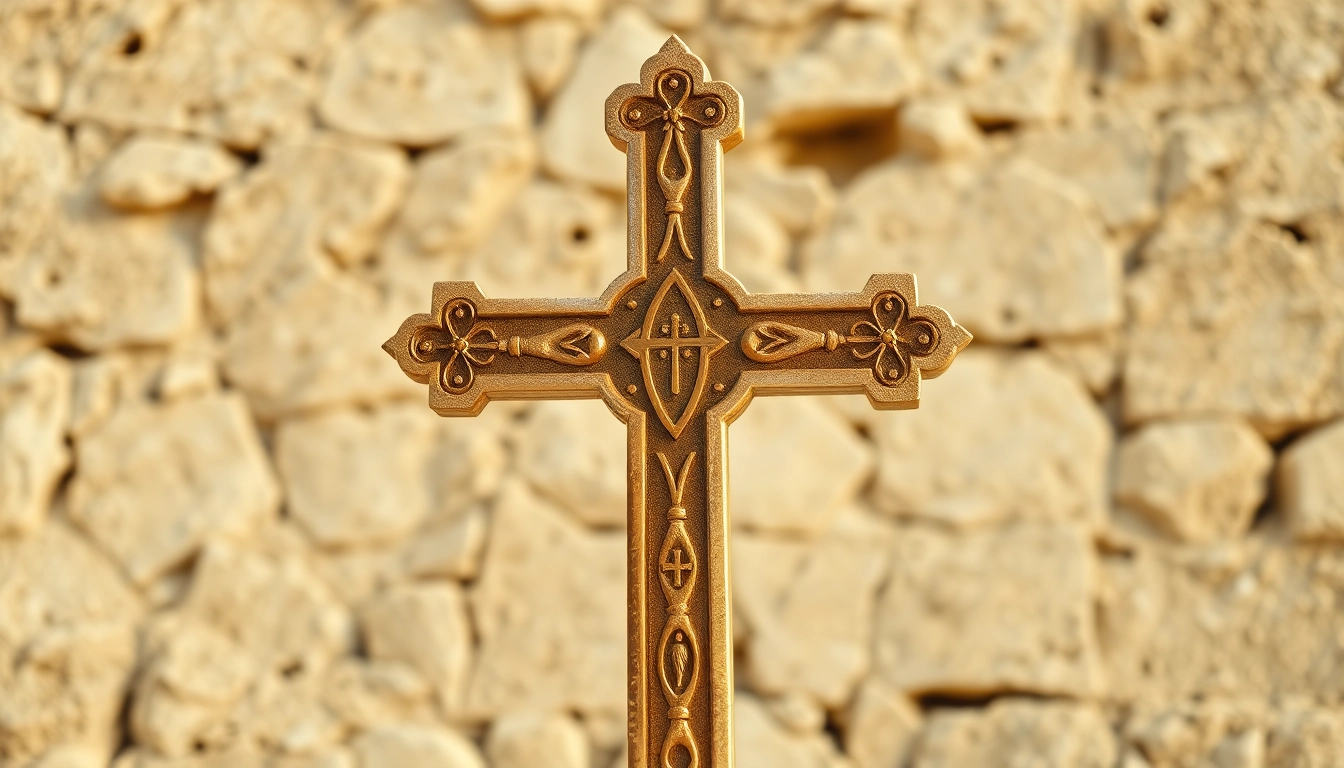Understanding Jerusalem Crosses
The Jerusalem cross, often referred to as the five-fold cross or the Crusader’s cross, is a significant emblem that carries profound religious, historical, and cultural implications. This emblem features a large cross potent surrounded by four smaller Greek crosses, representing the Four Evangelists and symbolizing the spread of Christianity from Jerusalem to the corners of the earth. Many practitioners and enthusiasts seek to learn more about Jerusalem crosses as not only a religious symbol but also as a historical artifact that connects the past and present.
The Origin of Jerusalem Crosses
The origins of the Jerusalem cross are steeped in the rich history of the Crusades, around the 11th century when this symbol emerged as an emblem for the Crusader Kingdom of Jerusalem. Following the First Crusade, the symbol was adopted by the knights and military orders, representing their commitment to the Christian faith and their mission to spread the Gospel. Over time, it evolved into a powerful symbol of faith for Christians worldwide.
In heraldic terms, the Jerusalem cross is categorized as a “cross-and-crosslets,” highlighting its unique design which consists of the larger central cross surrounded by the smaller ones. This design not only conveys a sense of authority but also acts as a reminder of the Four Gospels: Matthew, Mark, Luke, and John, emphasizing the role of evangelism in Christianity.
Design Elements of Jerusalem Crosses
The design of the Jerusalem cross is visually striking, making it an enduring favorite among religious symbols. The main element, a large cross, typically features arms of equal length, intersected at the center. This central cross represents Christ’s victorious resurrection and the Christian faith at large.
Surrounding this central figure are the four smaller crosses, each positioned in the quadrants created by the large cross’s arms. These crosses represent not only the evangelists but also the geographic and spiritual directions in which Christianity spread. The design’s simplicity hides a deep complexity, as it intricately intertwines faith and history.
Spiritual Significance of Jerusalem Crosses
For many believers, the Jerusalem cross holds profound spiritual significance. It serves as a reminder of Christ’s command to spread the Gospel. Each smaller cross signifies faith in action, encouraging believers to share their faith and values in their daily lives. This symbol can also be tied to the concept of spiritual vigilance, reminding practitioners of their mission to bear witness to their faith.
Moreover, the Jerusalem cross is often used in liturgical contexts, appearing prominently in church decorations, vestments, and some altar designs, reinforcing its status as a pivotal Christian symbol.
Symbolism Behind Jerusalem Crosses
Crosses in Christian Heritage
The historical context of the Jerusalem cross within Christian heritage cannot be overstated. It serves as an emblematic representation of the struggles and triumphs of early Christianity. As the Crusaders sought to reclaim the Holy Land, the Jerusalem cross became synonymous with their mission, embodying the hope and determination of believers throughout the ages.
Over the centuries, it was adopted by various Christian denominations as an emblem of unity and faith, transcending its geographical origins to become a universal symbol recognized by Christians worldwide.
Jerusalem Crosses as Emblems
Throughout history, the Jerusalem cross has been used as an emblem for various Christian organizations and missions. It forms an integral part of the insignia for the Order of the Holy Sepulchre, which is dedicated to safeguarding the Christian presence in the Holy Land. The emblem acts as a call to action, encouraging Christians to support the preservation of Christian heritage in Jerusalem.
Additionally, the Jerusalem cross has been incorporated into numerous church designs and is often integrated into personal artifacts such as jewelry, further solidifying its legacy and significance in contemporary Christian culture.
Interpretations of the Four Smaller Crosses
The four smaller crosses surrounding the central cross are rich with symbolism that invites myriad interpretations. While traditionally associated with the Four Evangelists, these smaller crosses can also represent the four cardinal directions—North, South, East, and West. This interpretation signifies the global outreach of Christianity and the missionary work initiated from the Holy Land.
Additionally, some theological teachings suggest that the smaller crosses can symbolize the four stages of spiritual growth, from initial belief and understanding to deeper missions in spreading faith. This layered meaning adds depth to the symbol and encourages believers to reflect on their personal spiritual journeys.
Jerusalem Crosses Across Cultures
Variations in Design
The Jerusalem cross has inspired numerous variations across different cultures, particularly in areas with significant Christian histories. In many Eastern Orthodox traditions, for instance, the Jerusalem cross may be designed with distinct stylistic elements that reflect local artistic traditions, sometimes incorporating additional symbols pertinent to regional beliefs.
These variations not only highlight the adaptability of the Jerusalem cross but also its universal appeal across cultures and traditions, revealing how a symbol can evolve while maintaining its core meaning.
Cross Symbolism in Different Faiths
The symbolism of the cross transcends Christianity and can be observed within other faiths as well. While generally not as prominent, the cross is recognized in certain elements of Jewish and Islamic teachings, where it often represents the challenges of faith and sacrifice. In some interpretations, it serves as a reminder of the interconnectedness of the Abrahamic faiths.
Understanding the cross’s recognition and adaptability within different cultural contexts fosters respectful interfaith dialogues, which is crucial in our increasingly multicultural society.
Global Recognition of Jerusalem Crosses
The Jerusalem cross is globally recognized, transcending geographic borders and cultural boundaries. It has become a powerful icon for Christians around the world, embodying the message of love, faith, and resilience in the face of adversity. As a popular symbol, it is commonly found in religious jewelry, art, and crafts, making it accessible to a broader audience.
Moreover, the Jerusalem cross frequently features in religious discussions and educational contexts, underscoring its importance as a topic of interest for both believers and historians alike.
Jerusalem Crosses in Art and Jewelry
Artistic Representations of Jerusalem Crosses
The Jerusalem cross has been the subject of various artistic representations throughout history, from paintings and sculptures to textiles and glass mosaics. Artists have used this powerful symbol to convey messages of faith and perseverance, capturing the essence of its meaning while allowing for personal interpretations.
In modern artworks, the Jerusalem cross is often utilized to explore themes of identity, spirituality, and the sacred, bridging traditional craftsmanship with contemporary artistic expressions.
Jewelry Featuring Jerusalem Crosses
Jewelry adorned with the Jerusalem cross serves as a popular choice for both aesthetic and religious expression. Items such as necklaces, bracelets, and earrings featuring this emblem can be found in many styles, often incorporating materials like silver, gold, and even precious stones. Such pieces are worn not only as fashion statements but also as personal declarations of faith.
Additionally, these items hold an emotional resonance for wearers as they symbolize their connection to a faith community, reminding them of their convictions and spiritual journey.
Craftsmanship and Material Choices
The craftsmanship behind Jerusalem cross jewelry and art is noteworthy, as artisans pay careful attention to the details that reflect the symbol’s significance. Various materials, including wood, metal, and stone, are often used, each chosen for its aesthetic properties and spiritual symbolism. The choice of material can add depth to the overall meaning and message conveyed by each piece.
Artisans often combine traditional methods with modern techniques to create unique expressions of the Jerusalem cross, making each piece a distinctive representation of personal beliefs and artistic vision.
Purchasing and Caring for Jerusalem Crosses
Where to Find Authentic Jerusalem Crosses
Finding authentic Jerusalem crosses requires discernment, as there are numerous replicas and mass-produced items on the market. It is essential to seek out reputable retailers that specialize in religious artifacts, particularly those with a direct connection to the Holy Land. These sellers typically offer a range of handcrafted items that uphold the cultural and spiritual significance of the Jerusalem cross.
Purchasing from artisans or stores that prioritize ethical sourcing can enhance the meaning behind the piece and contribute to the community that continues to uphold the tradition of crafting such symbols.
Caring for Jerusalem Crosses
To maintain the beauty and integrity of a Jerusalem cross, proper care is necessary. Depending on the material, different cleaning methods may be required. For instance, wooden crosses should be kept away from excess moisture to prevent damage, while metal pieces can be polished gently to maintain their shine. Additionally, ensuring that jewelry is stored in a safe place when not being worn can prevent scratches and wear over time.
Whether in art form or as wearable pieces, taking meticulous care of these crosses helps preserve their historical and sentimental value, making them cherished heirlooms for future generations.
Gifting Jerusalem Crosses
Jerusalem crosses make meaningful gifts for various occasions, including baptisms, confirmations, and weddings. The act of gifting such a profound symbol can deepen connections among family and friends, offering a tangible representation of shared faith and beliefs.
When gifting a Jerusalem cross, it is beneficial to also share its significance and any pertinent stories or traditions associated with it. Doing so can enrich the experience, adding layers of meaning to the gift and ensuring it is treasured and appreciated.



